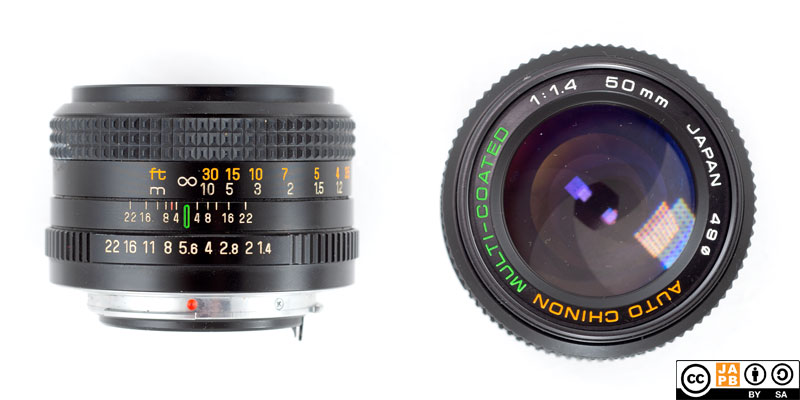Pekka Buttler, 02/2024

Specifications
The table below summarises the lens’ key specifications (measurements based on pictured sample):
| Brand: | Chinon | Lens name | Auto Multi-coated 1:1.4 f=50mm |
| Focal length(s) 1 | 50 mm | Angle-of-view 2 | 46,8 ° |
| Maximum Aperture | f/1.4 | In Production | ≈1975–1985 |
| Lens mount | Pentax K | Subfamily (if applicable) | K-type (see details) |
| Length 3 | 39,1 mm | Diameter 4 | 60,9 mm |
| Filter ring diameter | 49 mm | Weight | 245 grams |
| Lens element count | ? | Lens group count | ? |
| Aperture blades (S/R/C) 5 | 6 S | Focus throw | 210 ° |
| Minimum focusing distance | 45 cm | Maximum magnification | 1:6,9 |
| Has manual aperture ring | YES | Has Manual focus ring | YES |
| Aperture mechanism type | Automatic | Aperture click stops 6 | 1.4-2•2.8•4•5.6•8•11•16-22 |
Further notes:
• This lens was Chinon’s fast fifty during the period when its SLR cameras used the Pentax K mount.
• I have been unable to find trustworthy details on production dates, but Chinon quickly saddled over to the Pentax K mount after its introduction (1975) and largely lost its ambition in manufacturing SLRs after Minolta’s introduction of autofocus (1985). The actual production run might be significantly shorter.
• Somewhere in the production run of this lens, Chinon made a cosmetic change and changed the typography and colouring of the lens’ name ring: One version is as pictured above, another
• Chinon is not known for having manufactured the lenses it sold under the Chinon brand. Hence, the lens likely originates with a Japanese OEM manufacturer (Cosina is a relatively strong bet).
• Problematically, there is little hard knowledge about the lens’ optical design (elements & groups), compounded by the confusion caused by that the same lens also was sold as Auto Revuenon 50 mm f/1.4 [data sheet] and Agfa Color Multi-Coated 50 mm f/1.4 (see on Flickr) (and that there are two distinct versions of both the Auto Revuenon and Agfa Colot, with different barrel designs, different numbers of aperture blades, and – reportedly – different optical designs. Summarising the various online accounts, this lens either has a 7 elements in 6 groups design or a 6 elements in 5 element design (if I ever have cause to open this lens up and count the elements, I’ll update this data sheet). If you’re interested the convoluted versions of this lens, head to the data sheet of the Revuenon sibling.
Chinon company profile
Chinon is known to still photographers as one of the more advanced 2nd tier Japanese cameramakers. From 1971 to the late 1980s Chinon was known to enthusiast photographers the world over for combining technological advancements in cost-effective cameras bodies. See more details in the Chinon company profile.
Adapting
If you want to natively mount this lens you need to find a functioning Pentax K mount SLR (or a dSLR) camera. Luckily that should be relatively easy as Pentax K film bodies were produced in their millions and most of them – especially those manufactured by Pentax – have a good reliability record. Alternatively, you can use this lens natively on any Pentax dSLR.
Adapting this lens to a mirrorless, full-frame digital camera is a breeze thanks to the lens having full manual controls (aperture ring, focus ring). You simply need a dumb adapter from Pentax K to your mirrorless system.
Due to the medium flange focal distance used by the m42 mount (45,46 mm), whether you can adapt this lens to other than Pentax’ dSLR mounts depends on which dSLR mount: Canon EF, and Four Thirds can mount Pentax K lenses using a simple adapter ring. Minolta/Sony A and Nikon F on the other hand are not as problem-free, and – to retain anything near infinity focus – the adapter will necessitate corrective optics. In all cases, your camera will work only in stop-down metering.
Footnotes
- Focal length is (unless stated otherwise) given in absolute terms (not in Full-frame equivalent), and according to the manufacturer’s naming practice (which does not always reflect the lens’ actual field of view). For an understanding of whether the lens is wide/tele, see ‘Angle-of-view’. ↩︎
- Picture angle is given in degrees and concerns the diagonal picture angle. Rule of thumb:
> 90 ° ==> Ultra-wide-angle
70–90 ° ==> Wide-angle
50–70 ° ==> Moderate wide-angle
40–50 ° ==> ‘Standard’ or ‘normal’ lens
20–40 ° ==> Short tele lens
10-20 ° ==> Tele lens
5-10 ° ==> Long tele lens
< 5 ° ==> Ultra-tele lens ↩︎ - Length is given from the mount flange to the front of lens at infinity. Measured unless stated otherwise. ↩︎
- Diameter excludes protrusions such as rabbit ears or stop-down levers. Measured unless stated otherwise. ↩︎
- S=straight; R=rounded; C=(almost)circular at all apertures. ↩︎
- Numbers equal aperture values on aperture ring; • intermediate click; – no intermediate click. ↩︎